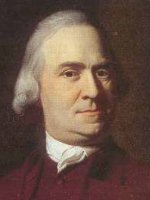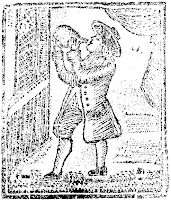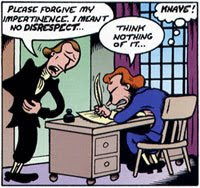Sion Seabury’s Bright Ideas
On 11 Nov 1774, a man from Tiverton, Rhode Island, wrote a letter to John Hancock, the head of the Massachusetts Provincial Congress that was meeting outside Boston to organize resistance to the royal authorities. Seabury said:
While anxiously concerned for the Destresses of Boston & devising Methods for its Relief, the preceeding Inventions occurred to my Mind, about six Weeks ago: which yielded me an assurance that the Canon and Works on Boston Neck might be safely approached & taken without the Loss of a single Life on our Part.Seabury (1713-1801) was a Presbyterian living in Tiverton in 1760, according to other notes from Stiles. I haven’t found any trace of his letter in Hancock’s correspondence as a delegate to the Continental Congress, in the published records of the Provincial Congress, or in newspapers. But the Rev. Dr. Ezra Stiles copied this letter and its enclosure into his diary on 5 December. Here are Seabury’s brilliant ideas:
I could not resist an Inclination I instantly conceived to communicate it for the Benefit of our suffering Brethren. The Invention was to me new & original as well as satisfactory. And altho’ I now understand that an Attack by a Line of Moveable Fascines has been thought of, & is now under Contemplation: Yet I am desirous of testifying my Ardor in the common Cause, by communicating my Method also.
I am, Sir,
Your unknown Humb. Servt.
Sion Seabury.
Inventions of Mr. Sion Seabury of Tiverton for the Relief of Boston in its present Siege.A couple of things struck me about these documents. First, New Englander that he was, Seabury felt that citing Biblical verses would show the value of his idea. The verses he had in mind:
1. A solid Timber Roller 7 or 8 feet Diameter & 8 or 10 feet more or less, to defend against the Canon on Bo[ston]. Neck. Sundry of these connected together by a Central Chain thro’ them all & Chains around them, will form an extended movable Breastwork for covering a Body of Men sufficient for seizing & possessing themselves of the Artillery & Fortifica. upon the Neck or elsewhere.
At the ends of the Line of Rolling Breastwork, may be a Range of Rollers following after, so as to guard the sides. A Mast or span at the open End, may keep the whole steady and at the same Time employ the Men in pulling aft as well as pushing forwards. The side Defence might be made with a Frame on small Wheels charged with Wool packs. The great Front Rollers may be made of Cedar or light Wood. (& perhaps in part filled with Wool or Wool-Rollers intirely.) Mr. Seabury thinks Wood only the best.
2. A Plank Breastwork to be carried to defend against Small Arms; and upon coming up to the Canon so that they are silenced or useless, to be raised up on the Top of the Front Line of Rollers, to cover the Men firing thro’ small port-holes to oblige the Engineers & Soldiery to abandon the Canon.
3. To blind and deceive the Enemy, (especially if the attack be in the Night) let several Bbs. [barrels] of Tarr or Pitch be set on fire between the Enemy’s Ships & place of Attack; this will render the Progress of the moveable Breastwork invisible to the Shipping, & be advantageous for the attack. These Tarbarrels might be fired on Water by Floats as well as on Land. The same Thing may be practised to render an Army invisible, should it in the Night march over Ice, or procede in Boats across the Water to Town. Exod. xiv, 19, 20.
And the angel of God, which went before the camp of Israel, removed and went behind them; and the pillar of the cloud went from before their face, and stood behind them:It doesn’t seem to have struck Seabury that that anecdote was supposed to be miraculous, not something that could be recreated with some tar barrels.
And it came between the camp of the Egyptians and the camp of Israel; and it was a cloud and darkness to them, but it gave light by night to these: so that the one came not near the other all the night.
Second, even in late 1774, more than four months before the Battle of Lexington and Concord, even before the exchange of fire at Portsmouth, Seabury was referring to the situation around Boston as a “siege” and trying to invent a military solution. Of course, he might have been a crackpot.
(The image above, showing the British army’s fortifications on Boston Neck later during the siege, comes from YankeeGhosts.com.)




 The story, such as there was of it: Barbara Gordon (secretly Batgirl) is a young Congresswoman in Washington. Dick Grayson (secretly Robin) is working as an intern in her office between college terms. They confront a mysterious and powerful apparition of Gen. Benedict Arnold, determined to overthrow the American republic.
The story, such as there was of it: Barbara Gordon (secretly Batgirl) is a young Congresswoman in Washington. Dick Grayson (secretly Robin) is working as an intern in her office between college terms. They confront a mysterious and powerful apparition of Gen. Benedict Arnold, determined to overthrow the American republic. And who is that man in red, watching the action? He reveals his true nature when Robin and Batgirl once again thwart Arnold’s murderous intentions.
And who is that man in red, watching the action? He reveals his true nature when Robin and Batgirl once again thwart Arnold’s murderous intentions. The Devil takes Arnold back to hell, Robin and Batgirl shake their heads in wonderment, and the U.S. of A. sails safely into its Bicentennial celebration. With an adventure like that, Batman Family sold so well that D.C. rushed out another issue reprinting an earlier story of the “Dynamite Duo.”
The Devil takes Arnold back to hell, Robin and Batgirl shake their heads in wonderment, and the U.S. of A. sails safely into its Bicentennial celebration. With an adventure like that, Batman Family sold so well that D.C. rushed out another issue reprinting an earlier story of the “Dynamite Duo.” Loyalty & Liberty is a webcomic that Tamara “Meezer” Clarke is producing here in Massachusetts. It’s a one-person labor of love, so the story appears slowly, about one page a week, and the punctuation in the word balloons isn’t always standard.
Loyalty & Liberty is a webcomic that Tamara “Meezer” Clarke is producing here in Massachusetts. It’s a one-person labor of love, so the story appears slowly, about one page a week, and the punctuation in the word balloons isn’t always standard. Clarke and her husband are Revolutionary War reenactors, so she values accuracy in visual details. Most comics artists who come to depict this period don’t realize, for instance, that a regular infantry uniform was different from the uniform for a light infantryman, a grenadier, or a musician, or that different regiments wore slightly different uniforms, or that “redcoats” in the Royal Artillery were blue. Clarke is interested enough in British army life to portray
Clarke and her husband are Revolutionary War reenactors, so she values accuracy in visual details. Most comics artists who come to depict this period don’t realize, for instance, that a regular infantry uniform was different from the uniform for a light infantryman, a grenadier, or a musician, or that different regiments wore slightly different uniforms, or that “redcoats” in the Royal Artillery were blue. Clarke is interested enough in British army life to portray 


 This comic uses repeated or barely changing panels, a technique discussed
This comic uses repeated or barely changing panels, a technique discussed  What’s the phrase I’m looking for? Oh, yes. Utterly and completely wrong.
What’s the phrase I’m looking for? Oh, yes. Utterly and completely wrong. This argument between parent and child parallels a common Revolutionary-era metaphor, which has come to dominate how we remember that conflict (as Michael Kammen analyzed in
This argument between parent and child parallels a common Revolutionary-era metaphor, which has come to dominate how we remember that conflict (as Michael Kammen analyzed in  (In the top two frames of the second page, note how Purvis sketches objects in the background with thinner lines and no dark areas, pushing our attention to the figures in the foreground.)
(In the top two frames of the second page, note how Purvis sketches objects in the background with thinner lines and no dark areas, pushing our attention to the figures in the foreground.)



